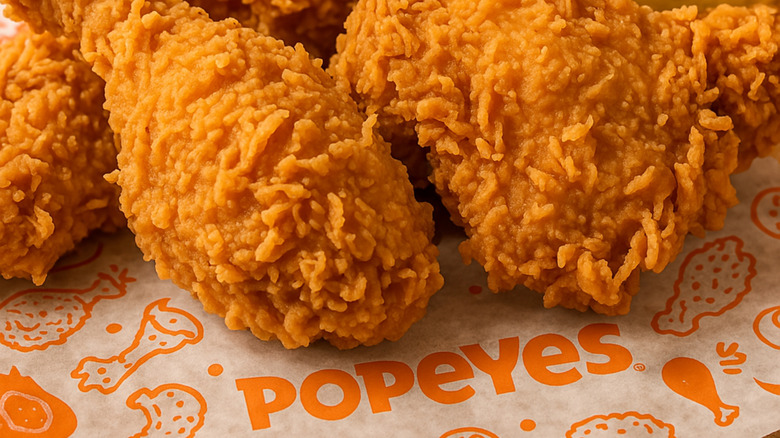Fried chicken is a quintessentially southern dish. So, it’s little surprise that two of the most popular fried chicken chains in the U.S., Popeye’s and Raising Cane’s, originated in the state of Louisiana.
Restaurant fried chicken always tastes better than what you make at home, which is one reason fast-food fried chicken is such a popular dining-out option. America is replete with fried chicken establishments, and each of these two national franchises ranks among the top fried chicken chains in the country.
Popeyes was launched in Arabi, Louisiana — a suburb of New Orleans — in 1972. Not far away but more than two decades later, Raising Cane’s got its start in Baton Rouge in 1996. Though they’re close Louisiana neighbors, some clear distinctions between Popeyes and Raising Cane’s can be found on their menus. Each chain has a fierce fan following, proving there are all kinds of tastes in this world. Some prefer the Creole- and Cajun-inspired flavors of Popeyes, while, for others, the streamlined menu at Raising Cane’s is just what the tummy ordered.
Near neighbors with widely different menu offerings
Popeyes’ menu is unquestionably more robust than Raising Cane’s. Popeyes serves up traditional bone-in fried chicken, as well as both bone-in and boneless chicken wings in various flavors, along with chicken tenders, and highly ranked chicken sandwiches, as well as fried seafood options. Plentiful sides include fried pickles, Cajun rice, mac & cheese, jalapeño peppers, and more. Seven wing sauces are on offer, along with nine other dipping sauces (Popeyes announced in March 2025 that it’s putting its sauces on grocery store shelves, too). There are also a handful of desserts to choose from on the menu.
Raising Cane’s, in contrast, has a much narrower menu — you might even say minimalistic — featuring just chicken fingers as its sole fried poultry offering. There are no bone-in options to be found. The lone sandwich on the menu piles three of the chicken fingers onto a toasted bun. Cane’s Sauce is the only dipping option, and the side dishes consist of just crinkle-cut fries, coleslaw, and Texas toast. But the simple menu was a deliberate part of the business plan when Todd Graves founded the restaurant, and he credits the limited options as the reason for his success. With a smaller scope, Raising Cane’s franchises can focus on quality and doing what they do really, really well.
A tale of two Louisiana chicken chains
Popeyes was founded by Al Copeland, who dropped out of school at 16 and bought a donut franchise at 18. This, along with other food service experiences he had as a teen, was where he learned the tricks of the restaurant trade. He launched his now legendary fried chicken chain while in his 20s.
Before it was Popeyes, the restaurant was known as Chicken on the Run, and it featured a more traditional fried chicken recipe. The name and the chicken didn’t attract the success Copeland was looking for, though, so he rebranded the restaurant and revamped the chicken. He renamed the business Popeyes Mighty Good Chicken after “The French Connection” character Popeye Doyle, and he gave the fried poultry a New Orleans spice upgrade — the signature taste diners enjoy today. Over its 50+ year history, the company has expanded worldwide to include thousands of franchises spanning the globe.
Raising Cane’s was born out of a college business class project, though founder Graves was given a poor grade, because the professor believed a diner that only served chicken fingers would never succeed. Financial institutions felt similarly and turned him down for loans. Graves was undaunted, though, and he worked long hours at difficult jobs to earn enough money to fund the restaurant himself. When he launched Raising Cane’s he even did much of the renovation on the site. Graves still maintains that all-in attitude, and he remains at the helm of Raising Cane’s — a rarity for such a large food chain.







